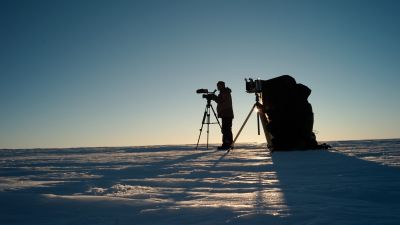
Encountering Wildlife at the Coast of Antarctica
During scientific research expeditions and traverses to pick up supplies brought by cargo ship to the coast of East Antarctica, the possibility of encountering Antarctic wildlife is pretty high. Here are some pictures of the memorable moments when members of the BELARE team spotted Weddell seals and a colony of emperor penguins.
-
A Weddell seal rests on the sea ice. Weddell seals can swim and forage for food as deep as 600 metres for up to an hour. without having to comes up again for air.
© International Polar Foundation
-
Despite their calm demeanour, Weddell seals are classified as top predators in the Antarctic. They can eat up to 50 kilogrammes of fish, cephalopods and crustaceans.
© International Polar Foundation
-
Late in the night, the sun hides behind the ice shelf but can never fully set providing a 24 hour daylight in this season.
© International Polar Foundation
-
Seals are often found near a hole in the ice. They maintain this hole to have constant access to the sea and make sure they can reach the surface at any time while foraging.
© International Polar Foundation
-
The Weddell seal is one of the largest seals and can measure up to 3.5 metres and weigh up to 600 kg. It is most often found on the fast ice.
© International Polar Foundation
-
Penguins gather in colonies to breed. The colonies are often located where ice cliffs offer some protection from the winds. Colonies may be home to several thousands of penguins.
© International Polar Foundation
-
Emperor penguins can recognize their own chick among a large group of chicks waiting for their parents and the meal their parents bring back for them. Each mating pair usually produces one chick.
© International Polar Foundation
-
During the austral summer, the chicks are grouped into "nurseries" while the parents go to the sea to feed and bring the necessary food for their own chick.
© International Polar Foundation
-
Near the ice edge, the adult penguins gather in groups before going out to sea to feed and bring back food for their chick. They usually follow each other on the way to the colony and back to the coast.
© International Polar Foundation
-
A group of adults gathers near the ice edge, resting before they go diving to gather food to feed their chicks.
© International Polar Foundation
-
Emperor penguins are the tallest and heaviest endemic bird in Antarctica. They can measure up to 122 cm and weigh up to 45 kg.
© International Polar Foundation
-
An Emperor penguin has found its chick. As emperor penguins have no fixed nests, they rely on vocal calls to locate their own chick.
© International Polar Foundation
-
This chick is nearly as big as its parents. Soon, little black patches will appear on its flippers and real feathers will begin to grow.
© International Polar Foundation
-
The Emperor penguin is classified as "near threatened" on the IUCN (International Union for Conservation of Nature) Red List. The main threat to the emperor penguin is reduced availability of their main food sources, due to the consequences of climate change and industrial fisheries.
© International Polar Foundation






